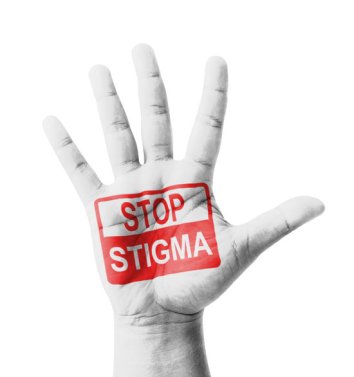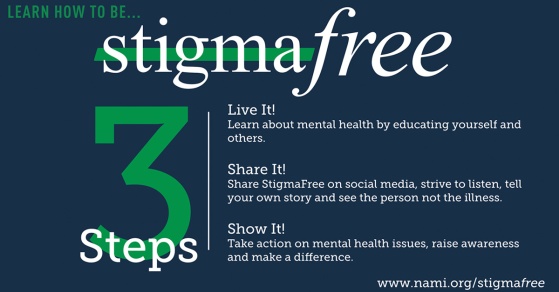People afflicted with serious mental illness face many challenges. Besides their struggle with their symptoms and disabilities that result from the SMI they also have to face the challenges by the stereotypes and prejudice that result from misconceptions about mental illness. As a result, they are robbed of the opportunities that define a quality life: good jobs, safe housing, satisfactory health care, and affiliation with a diverse group of people. Research has gone far to understand the impact of the disease, however, it has only recently begun to explain the stigma in mental illness and it may take time to get to a point where we will fully understand the breadth and scope of prejudice against people with mental illness.

What is mental health stigma? We all have mental health, like we all have physical health. Both change throughout our lives. And, like our bodies, our minds can become unwell. Mental health problems might actually be more common than you think. One in four of us will be affected by mental illness in any year. It is as real as being diagnosed with any acute medical illness like heart disease, diabetes or cancer.
The impact of Mental Health stigma can be divided into several types: social stigma is characterized by prejudicial attitudes and discriminating behaviour directed towards individuals with mental health problems as a result of the psychiatric label they have been given. In contrast, perceived stigma or self-stigma is the internalizing by the mental health sufferer of their perceptions of discrimination (Link, Cullen, Struening & Shrout, 1989); perceived stigma which can significantly affect feelings of shame and lead to poorer treatment outcomes (Perlick, Rosenheck, Clarkin, Sirey et al., 2001); public stigma is the reaction that the general population has to people with mental illness and self stigma is the prejudice which people with mental illness turn against themselves. Both public and self-stigma may be understood in terms of three components: stereotypes, prejudice, and discrimination. Social psychologists view stereotypes as especially efficient, social knowledge structures that are learned by most members of a social group . Stereotypes are considered “social” because they represent collectively agreed upon notions of groups of persons. They are “efficient” because people can quickly generate impressions and expectations of individuals who belong to a stereotyped group. (Sources: World Psychiatry & Psychology Today).

Why does stigma matter?: Stigma embraces both prejudicial attitudes and discriminating behaviour towards individuals with mental health problems, and the social effects of this include exclusion, poor social support, poorer subjective quality of life, and low self-esteem (Livingston & Boyd, 2010). As well as it’s affect on the quality of daily living, stigma also has a detrimental affect on treatment outcomes, and so hinders efficient and effective recovery from mental health problems (Perlick, Rosenheck, Clarkin, Sirey et al., 2001). In particular, self-stigma is correlated with poorer vocational outcomes (employment success) and increased social isolation (Yanos, Roe & Lysaker, 2010). These factors alone represent significant reasons for attempting to eradicate mental health stigma and ensure that social inclusion is facilitated and recovery can be efficiently achieved. (Source: Psychology Today).

It is certainly true that people with mental illness are taught to feel shame ― to believe that they have a character deficiency that is disgraceful, “all in their heads” or something to just “get over.” But the way we collectively treat people with mental illness goes far beyond that.
People with a mental illness are more likely to encounter law enforcement than get medical help during a psychological crisis. There are currently more people with mental illness in jails and prisons than in hospitals. They’re blamed for violencewhen they’re more likely to be the victims. They have higher rates of homelessness. They’re seen as a danger to society, to other people, to themselves. (Source: Huffington Post)

Individuals, companies, organizations and others can all take the pledge to learn more about mental illness, to see a person for who they are and take action on mental health issues. Take the pledge and raise awareness.
Join thousands of people across the country changing the stigma of mental health conditions.
Take the PLEDGE – USA
In the UK, the “Time to Change” campaign is one of the biggest programmes attempting to address mental health stigma and is supported by both charities and mental health service providers (http://www.time-to-change.org.uk). This programme provides blogs, videos, TV advertisments, and promotional events to help raise awareness of mental health stigma and the detrimental affect this has on mental health sufferers. However, raising awareness of mental health problems simply by providing information about these problems may not be a simple solution – especially since individuals who are most knowledgeable about mental health problems (e.g. psychiatrists, mental health nurses) regularly hold strong stigmatizing beliefs about mental health themselves! (Schlosberg, 1993; Caldwell & Jorm, 2001). As a consequence, attention has turned towards some methods identified in the social psychology literature for improving inter-group relations and reducing prejudice (Brown, 2010). These methods aim to promote events encouraging mass participation social contact between individuals with and without mental health problems and to facilitate positive intergroup contact and disclosure of mental health problems (one example is the “Time to Change” Roadshow, which sets up events in prominent town centre locations with high footfall). Analysis of these kinds of inter-group events suggests that they (1) improve attitudes towards people with mental health problems, (2) increase future willingness to disclose mental health problems, and (3) promote behaviours associated with anti-stigma engagement (Evans-Lacko, London, Japhet, Rusch et al., 2012; Thornicroft, Brohan, Kassam & Lewis-Holmes, 2008). A fuller evidence-based evaluation of the Time to Change initiative can be found in a special issue dedicated to this topic in the British Journal of Psychiatry (British Journal of Psychiatry, Vol. 202, Issue s55, April 2013). For those of you that would like to test your own knowledge of mental health problems,Time to Change provides you with a quiz to assess your own awareness of mental health problems. (Source: Psychology Today)
Take the PLEDGE – UK
If you or someone you know needs help, call 1-800-273-8255 for the National Suicide Prevention Lifeline. Outside of the U.S., please visit the International Association for Suicide Prevention for a database of resources.
NAMASTE!
LIVE  LAUGH … BELLE PAPILLON
LAUGH … BELLE PAPILLON 
Thank you for taking the time to read this post. Please remember to like, comment, share, and “follow” and/or subscribe here before you leave. Have a blessed day! Come join me on Twitter , Facebook and Instagram. See you there!


